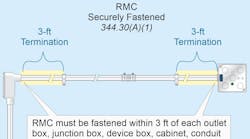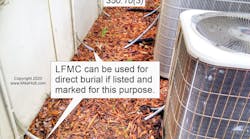All questions and answers are based on the 2011 NEC.
Q. Is the service neutral conductor allowed to perform bonding between the meter can and disconnect?
A. Yes. Electrical continuity at service equipment, service raceways, and service conductor enclosures can be established by bonding the metal parts to the service neutral conductor [250.92(B)(1)], as shown in Fig. 1 (click here to see Fig. 1).
A main bonding jumper is required to bond the service disconnect to the service neutral conductor [250.24(B) and 250.28]. At service equipment, the service neutral conductor provides the effective ground-fault current path to the power supply [250.24(C)]; therefore, an equipment grounding conductor is not required to be installed within PVC conduit containing service-entrance conductors [250.142(A)(1) and 352.60 Ex 2].
Q. When is a grounding electrode required for a separate building that is supplied by a feeder or branch circuit?
A. In all cases, except where supplied by a single branch circuit or multiwire branch circuit. Each building/structure supplied by a feeder or branch circuit must have its disconnect connected to an electrode of a type identified in 250.52 [250.32(A)].
Exception: A grounding electrode is not required where the building/structure is served with a 2-wire, 3-wire, or 4-wire multiwire branch circuit.
The grounding of the building/structure disconnecting means to the earth is intended to help in limiting induced voltages on the metal parts from nearby lightning strikes [250.4(A)(1)]. The Code prohibits the use of the earth to serve as an effective ground-fault current path [250.4(A)(5) and 250.4(B)(4)].
Q. In what rooms of a dwelling unit are switched receptacles allowed to be used for the required lighting outlets?
A. At least one wall switch-controlled lighting outlet must be installed in every habitable room and bathroom of a dwelling unit [210.70(A)(1)]. See the definition of “Lighting Outlet” in Art. 100.
Exception 1: In other than kitchens and bathrooms, a receptacle controlled by a wall switch can be used instead of a lighting outlet.
Exception 2: Lighting outlets can be controlled by occupancy sensors equipped with a manual override that permits the sensor to function as a wall switch.
The Code specifies the location of the wall switch-controlled lighting outlet, but it does not specify the switch location. Naturally, you would not want to install a switch behind a door or other inconvenient location, but the NEC does not require you to relocate the switch to suit the swing of the door. When in doubt as to the best location to place a light switch, consult the job plans, or ask the customer. The UBC/IBC has specific requirements as to the location and handicap heights of lighting switches. Electrical contractors should make themselves familiar with these sections, or contact the local building departments for the information. It could save the time and cost of changing the location later on.
Q. What are the permitted methods for terminating equipment grounding conductors, grounding electrode conductors, and bonding jumpers?
A. Equipment grounding conductors, grounding electrode conductors, and bonding jumpers must terminate in one of the following methods [250.8(A)]:
- Listed pressure connectors
- Terminal bars
- Pressure connectors listed for direct burial or concrete encasement [250.70]
- Exothermic welding
- Machine screws that engage at least two threads or are secured with a nut.
- Self-tapping machine screws that engage at least two threads
- Connections that are part of a listed assembly
- Other listed means.
Q. What identification is required for a panelboard that contains a 3-phase, 4-wire, 120/240V delta-connected system?
A. A switchboard or panelboard containing a 4-wire, delta-connected system where the midpoint of one phase winding is grounded shall be legibly and permanently field-marked as follows [408.3(F)(1)]: “Caution _____ Phase Has _____ Volts to Ground”.
Q. When a panelboard is supplied by a 4-wire, delta-connected, 3-phase (high-leg) system, where must the high-leg conductor terminate?
A. Panelboards supplied by a 4-wire, delta-connected, 3-phase (high-leg) system must have the high-leg conductor (which operates at 208V to ground) terminate to the “B” phase of the panelboard [408.3(E)], as shown in Fig. 2 (click here to see Fig. 2). However, an Exception to this rule states: The high-leg conductor can terminate to the “C” phase when the meter is located in the same section of a switchboard or panelboard. Note: Orange identification, or some other effective means, is required for the high-leg conductor [110.15 and 230.56].
Warnings: The ANSI standard for meter equipment requires the high-leg conductor (208V to neutral) to terminate on the “C” (right) phase of the meter socket enclosure. This is because the demand meter needs 120V, and it gets it from the “B” phase.
When replacing equipment in existing facilities that contain a high-leg conductor, use care to ensure that the high-leg conductor is replaced in the original location. Prior to 1975, the high-leg conductor was required to terminate on the “C” phase of panelboards and switchboards. Failure to re-terminate the high leg in accordance with the existing installation can result in 120V circuits being inadvertently connected to the 208V high leg, with disastrous results.


